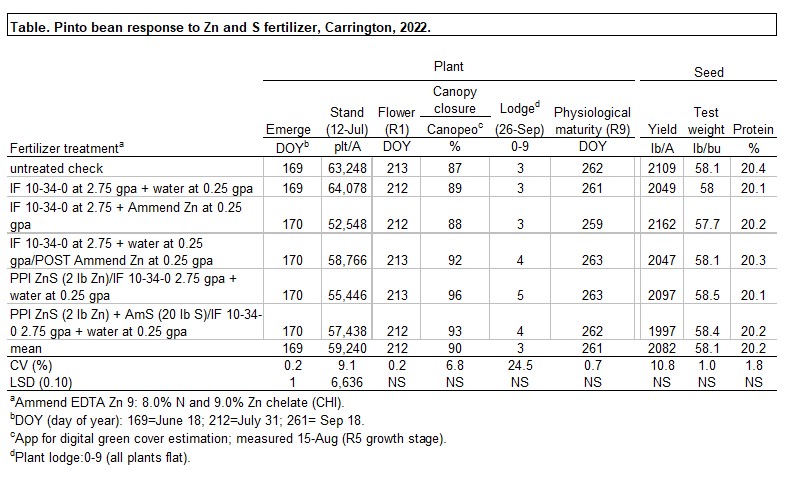The field trial was conducted at the NDSU Carrington Research Extension Center with support from Northarvest Dry Bean Growers Association to examine the performance of pinto bean with preplant incorporated (PPI), in-furrow (IF) and/or post emergence (POST) zinc (Zn) and sulfur (S) fertilizer. Experimental design was a randomized complete block with four replications. Previous crop in 2021 was barley. The dryland experiment was established on a conventional-tilled loam soil with 2.8% organic matter, 8.2 pH (0- to 6-inch depth), 5 ppm (Olsen = low) P, 146 ppm K and 0.54 ppm (low) Zn. The broadcast fertilizer treatments were PPI applied and shallow incorporated on May 26. Fungicide-treated ‘ND Falcon’ was planted with a 4-row JD Flex planter in 30-inch rows on June 8. Starter fertilizer was IF applied at planting. The POST foliar fertilizer treatment was applied on July 13 at the V5 growth stage with a hand-boom sprayer delivering 14 gpa through TeeJet AR 8001VS flat-fan nozzles at 35 psi. Plants were hand-pulled for field drying on September 27 and seed harvested with a plot combine on September 29.
Days from pinto bean planting to plant emergence, flowering, and maturity generally were similar among treatments (Table). Early season plant density about one month after emergence averaged 59,240 plants/acre across the trial. Compared to the untreated check (63,250 plants/A), crop stand with most fertilizer treatments (all included IF applications) tended or were statistically reduced. Canopy closure (August 15; R5 growth stage) evaluated with Canopeo was similar among treatments. Plant lodging evaluated Sept. 26 was similar among treatments. White mold was present in the trial at very low levels not impacting seed yield. Seed yield, test weight and protein were similar among treatments.

